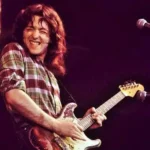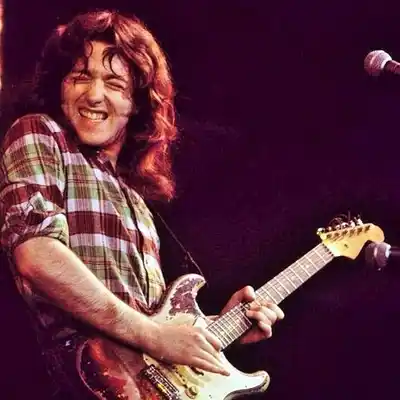
Rory Gallagher And His Iconic Guitars
Rory Gallagher was an Irish blues-rock guitarist, singer, and songwriter. Known for his raw and emotive playing style, Gallagher left a lasting impression on countless musicians and fans worldwide.
In this post, we delve into the life of Rory Gallagher, exploring the guitars he used, and the equipment that helped shape his signature sound.
Table of Contents
Life
Born on March 2, 1948, in Ballyshannon, County Donegal, Ireland, Rory Gallagher grew up in a musical family. His father, Daniel, played the accordion, while his mother, Monica, was a singer.
Rory’s love for music was apparent from an early age, and at just 9 years old, he received his first guitar.
In the 1960s, he formed the band “Taste,” which served as a springboard for his solo career.
Throughout the 1970s and 1980s, Gallagher released numerous albums and played at various music festivals, earning a dedicated fan base that appreciated his unique blend of blues, rock, and folk.
Tragically, Rory Gallagher passed away on June 14, 1995, at the age of 47, due to complications from a liver transplant. But his music continues to inspire generations of guitarists and fans.
Guitars
Rory Gallagher’s guitar collection was as eclectic as his playing style. Here, we highlight some of his most iconic instruments:
- 1961 Fender Stratocaster: Gallagher’s most famous guitar, a sunburst Stratocaster, was purchased in 1963. The guitar, which was heavily worn and modified over the years, became an essential part of his sound. It featured a rosewood fingerboard, three single-coil pickups, and a synchronized tremolo system. Rory famously played this guitar on nearly all of his recordings and live performances.
- 1966 Fender Telecaster: Another staple in Gallagher’s collection was a 1966 Telecaster, often used for slide guitar. With its distinctive bright and twangy tone, the Telecaster added a unique dimension to Rory’s sound.
- 1968 Gibson Les Paul Standard: Gallagher also played a sunburst Gibson Les Paul Standard, notable for its powerful humbucking pickups and solid mahogany body. This guitar can be heard on several recordings, particularly those with a heavier rock influence.
- Martin D-35 Acoustic: When it came to acoustic guitars, Rory often relied on his Martin D-35. Known for its deep, resonant tone, the D-35 suited Gallagher’s fingerpicking and strumming styles perfectly.
Guitar Equipment
Rory Gallagher’s tone was not only shaped by his choice of guitars but also by the equipment he used. Here are some key components of his rig:
- Amplifiers: Gallagher primarily used vintage Fender and Vox amplifiers. His go-to amps included the Fender Bassman, Fender Twin Reverb, and Vox AC30. These amps, known for their warm, clean tones and rich harmonics, contributed significantly to Rory’s signature sound.
- Effects Pedals: While Rory was not a heavy user of effects, he did employ a few key pedals to enhance his tone. These included the Dallas Rangemaster treble booster, which added bite and sustain to his sound, and the Ibanez Tube Screamer, used for smooth overdrive.
- Slide: Rory Gallagher was an accomplished slide guitarist, often using a brass or glass slide to achieve a distinctive, expressive sound.
Legacy
Rory Gallagher’s legacy as a guitarist, singer, and songwriter remains strong, inspiring countless musicians and fans. He left an indelible mark on the world of blues and rock music.
Some notable musicians who have cited Gallagher as an influence include Brian May of Queen, Slash of Guns N’ Roses, and Joe Bonamassa.
In addition to his musical contributions, Rory Gallagher’s down-to-earth personality and humble nature also made him a beloved figure among his fans. He was known for his approachability and readiness to engage with his audience.
Several tributes have been organized to celebrate Rory’s life and music since his passing. One of the most significant events is the annual Rory Gallagher International Tribute Festival, held in Ballyshannon, Ireland. The festival attracts thousands of fans from around the world, who gather to celebrate Gallagher’s music through live performances, exhibitions, and workshops.
Rory’s extensive discography, which includes albums like “Rory Gallagher” (1971), “Tattoo” (1973), and “Irish Tour ’74” (1974), remains popular among blues-rock enthusiasts. Additionally, several posthumous releases, such as “Notes From San Francisco” (2011) and “Blues” (2019), have helped to further solidify his place in music history.
In 2020, Gallagher’s Stratocaster was immortalized by the Fender Custom Shop, which released a limited-edition replica of his iconic guitar. This tribute guitar features the same specifications, wear, and modifications as Rory’s original instrument, allowing fans and musicians to experience a piece of his legacy firsthand.
